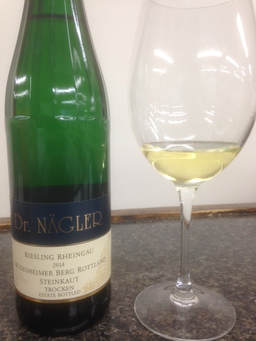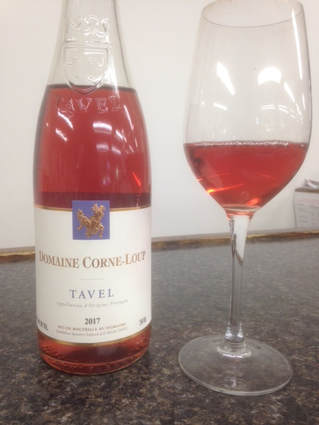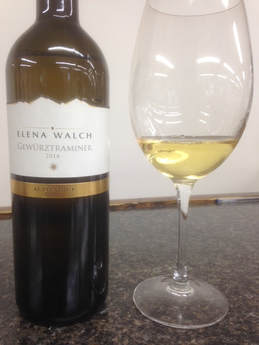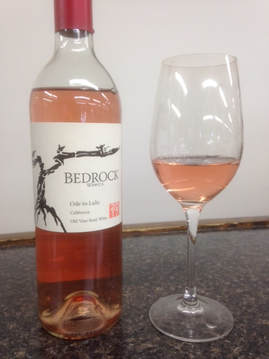 Hoping everyone in the Charlottesville area are safe and well this morning after the rain and flooding last night. Definitely not a day to casually travel around and taste wine for many people, hopefully tomorrow will clear out some. For those that ARE able to be out and about today, we thought it appropriate to have the word of the day be 'DRY'. Think dry thoughts, and drink dry Riesling, or 'Trocken' as the Germans will note on their labels. Many consumers still think all Riesling is sweet, and while the sweet versions are prevalent in the market there is actually a great diversity in styles that Riesling can cover, perhaps better than any one grape variety. In fact, Trocken level Rieslings have less residual sugar than a very large percentage of Chardonnays that consumers think of as 'dry' and 'smooth', where much of the sense of sweetness is covered over by oak and/or buttery characteristics. The full name of this wine (including town and vineyard site) is Dr. Nagler Rudesheimer Berg Rottland Steinkaut Trocken, but that would have made your browser blow up. But it is important to note that this is a single vineyard, single site wine, and is built with the desire to show a lot of distinct character. After flavors an initial puff of petrol aromas when first opened (very common in drier to off-dry Riesling) the nose develops lots of white stone fruits, pear skins, and even some honeycomb-like notes. To many, this may prime your palate for sweeter flavors and sensations on the first sip. Think again, as your mouth fills with racy heirloom apple tones and wet stones that linger for almost a minute on the long nervy finish. Deliciously food friendly with all sorts of poultry and savory dishes, even capable of handling creamier sauces, and above all a great DRY wine option,
0 Comments
 Unofficially, the official Rose wine season is in full swing now, as the vast majority of the new vintages have arrived and the warm weather is here to stay. Great Rose comes from everywhere these days, utilizing pretty much every grape that makes a red wine, but there is always something to be said for the time honored classics of Southern France. It's like comfort food, so consistent and fulfilling it doesn't need to be re-imagined or reinvented in order to be enjoyable and exactly what we want. The Tavel region sits just across the river from Chateauneuf-du-Pape, and is a rare Rose-only appellation in France especially being surrounded by big name red wine producers. Fans of Provence style Rose will notice a distinct color difference in Tavel versions, a deeper ruby color instead of the famous pale salmon pink. Tavel Rose (and in general other Rhone based Rose of a similar color) is built from a higher percentage of Grenache in the blend versus Cinsault, which has more natural pigment in the skins. Even though the juice spends the briefest of time during pressing in contact with the skin, it is enough to create this dramatic color change. Grenache is also naturally less acidic, which gives their Roses a juicier texture and softer fruit on the palate. From the first whiff the aromas are all juicy strawberries and cherry skins that build and take over the glass as it opens up, with hints of citrus and some savory herbs in the background thanks to the complimentary role of the other grapes in the blend. Straight Grenache Rose almost verges into the sweeter fruit category, so the 35% or so of other varieties help keep that tendency in check and greatly influence the complexity. The palate is fuller for a Rose, round and mouth-filling, almost the texture of an unoaked Chardonnay but for a prickle of tart apple skin type acidity and light tannin on the finish. The juicy red fruits are pulpy fresh and fill the palate quite nicely, seriously flavorful but still easy enough to be enjoyed by all. Great for easy sipping but also textured enough to pair well with lighter pork or chicken dishes for back porch summertime meals.  Experimentation isn't common in the more tradition oriented regions like the Piedmont in Italy, but can produce astounding results even in small doses. About 35 years ago the Baudana family planted a small parcel of white grape varieties in their portion of the Ceretta vineyard in Barolo to see which ones worked the best in their environment. The Chardonnay, Riesling, and Sauvignon Blanc vines were planted alongside the local Nascetta, with the intention of replanting the vines back to Nebbiolo after a decade or so once they had enough data. The problem (if you can call it that) developed when the white wine they made using the grapes became too delicious to get rid of, and they chose to not replant. In the midst of vines producing fantastic red wine this parcel of white grapes brings forth a great sense of character and terroir unlike anything else, yet still tastes distinctly of the Langhe. Beautiful straw gold color in the glass, with equally fresh aromas to match with lots of dried flowers and hay, also some subtle white fruits popping out with a few swirls of the glass. The nose isn't opulent or in your face with any one aroma, but a lovely marriage of everything involved. On the palate the unoaked Chardonnay is present mostly in the body, providing some rich texture that allows the bright fruit and penetrating citrus skin textures to show through with more intensity. There is also lots of minerality that pierces through on the finish as well, expressed almost as a salty lime character, which is a vineyard aspect that comes through on the Barolo from their adjacent site. This is always a fun summertime wine, and even though they don't make that much we look forward to showing it off every vintage. INSIDER'S PICK: 2016 ELENA WALCH GEWURZTRAMINER ALTO ADIGE (Wine Spectator 89points) $20.995/10/2018  There are legions of grape varieties that unjustly get lumped into being thought of as ONLY making sweet wines, mostly the naturally perfumed and aromatic ones like Gewurztraminer. While the sweet versions can be delightful, they can get cloying and very limiting in how you can use them or pair them. But there is soooo much more to them than just one note. As the great versions of Rieslings and Viogniers have shown (and increasingly varieties like Muscat and Malvasia) dry wines from these grapes can excel among the finest white wines in the world, and more examples of the everyday versions should be made much more often. The cool, high altitude vineyards of the Alto Adige in Italy is a perfect climate for Gewurztraminer to perform, perhaps second only to Alsace in terms of both quality and quantity of wines produced. The perfume of Gewurztraminer is immediately recognizable in the glass, with spice, honeysuckle, and wildflowers noticeable from several feet away. The intensity of aromas isn't lost in a dry version, just some of the more persistently sugary sides. The natural richness in the mouth is still present as well, but immediately the drier stone fruits take over on the palate, as well as the tingly penetrating acidity and hints of skin tannins, giving the finish a sense of melon rind behind the dried orange tones. A tricky aspect of making a drier Gewurztraminer is balancing out the inevitable higher alcohol that comes with fermenting out all the natural sugars (tip: in general the lower the alcohol by volume listed on the wine label for a Gewurztraminer, the sweeter it will be), but here the natural weight and complexity compensate perfectly and there is no heat element here. This will perform perfectly with all the usual food matches Gewurztraminer is recommended for, but the dryness opens up the possibility for so much more, such as poultry or seafood with lots of Mediterranean spice and citrus influence.  This is a gutsy Rose for a winery to make. First off, dedicating it by name to Lulu Peyraud, the matriarch of Domaine Tempier in Bandol, which is historically one of the great sources in the world for top flight Rose. That's an extremely high bar to set as your standard.Secondly, the age of the vines being used are usually reserved to make top end high dollar reds, so to use them in 'just' a Rose is equally bold. But the results are hard to deny when the YOUNGEST vines you use are nearly 70 years old, and the oldest are pushing into the middle third of their second century. Simply put, this is about as good a domestic Rose as you will find on the market, contending with the best names in Provence. Classic strawberry leaf and dusty watermelon aromas come forward readily from the glass, walking the line between juicy and savory. The palate is a dream for Rose fans, showing lots of body and texture while delivering dry red fruit flavors and leafy herbal tones all across the tongue, as well as a bright acidity to the finish that leaves an almost minty tone lingering. |
The Best of the Best.We offering free tastings on these wines in the store every Thursday and Friday, and a 10% discount off the retail price through the duration of the day. Come on by and give them a try! Archives
July 2024
Categories |
Location |
|

 RSS Feed
RSS Feed